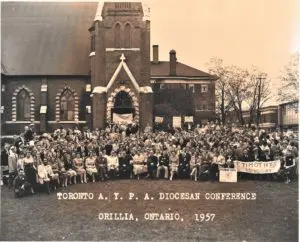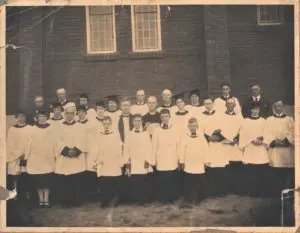
Photographs
There’s a saying that a picture is worth a thousand words, as the image can often convey more than words alone can. However, the true meaning and story told by the photograph may be lost without some identifying information. It is important to provide some written context for the photograph, such as the date it was taken, the name of individuals photographed, and the event or location where the photograph was taken. This ensures that when future generations engage with the photograph, they can understand the context and historical significance. To make sure the photograph isn’t damaged when adding this information, you can use an index card stored behind the photograph in a photo album or storage box. If it’s possible that this card will become separated from the photograph, writing on the back of the photograph with a pencil is an acceptable choice. Write lightly around the edges to avoid damaging the focus of the photograph at the center. Once you’re finished writing, avoid touching the pencil marks so you don’t smudge the writing.
It is also important to keep only photographs that have some historical value, which means that it provides evidence of people, places, or events significant to a parish or church organization. Ideally, the subject of the photograph should be clear and identifiable. If you have multiple photographs showing the same image from the same event only keep the best one. This is necessary as photographs can take up a lot of room for storage.

With photographs that have been determined to be of historical value, it’s important to store them correctly to ensure their ongoing preservation. They can be stored in a box or in albums. If stored in a box, the box should be archive safe quality that is acid-free and lignin-free, as photographs stored in an acidic environment will become discoloured over time.
If stored in a photograph album, the photographs should not be adhered to the pages in any way, as glue and tape can cause discolouration. Using tape on a photograph to fix a tear or to adhere it to a page leads to the risk of losing part of the image where it is applied. This can occur if the tape pulls away from the image, which can happen as tape becomes brittle over time. Instead, photographs should be kept in acid-free plastic sleeves.

Larger format photographs should be stored flat, and items of like sizes stored together to keep them from bending. Smaller format photographs may be stored vertically, as long as there are enough photographs in a box together to keep them from slumping. If loose photographs are not correctly stored they can bend, crease, and tear, leading to image loss over time.
Photographs should be handled with care and only touched while wearing white cotton, nylon or vinyl gloves to avoid oils from fingers being left on the surface of the photograph, leading to deterioration over time.
If the photograph is in fragile condition, arrangements should be made to transfer it to the Archives so we can ensure it is stored in the best conditions possible.
As most people now take digital photographs, it’s also important to consider their long-term preservation, as well as access considerations. To ensure you can easily find the digital photograph that you’re looking for on your computer, save them with a file name that identifies a person or event. Consider printing a few digital images as hard copy photographs, as it can serve as a crucial backup to your digital collection and act as a way to interact with history, now and in the future. For photographs that are only kept in born digital format, it’s important to ensure that they are backed up regularly for ongoing preservation.
We hope you have enjoyed learning more about Preservation and Conservation issues and Archives over the last five weeks. If you have any questions about what we have shared please be in touch!